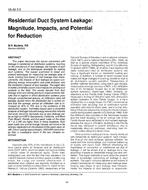Description
This paper discusses the issues associated with leakage in residential air distribution Systems, touching on the prevalence of duct leakage, the impacts of duct leakage, and on the techniques available for sealing duct systems. The issues examined in detail are: present techniques for measuring the leakage area of ducts, existing data bases of duct leakage area measurements, the impacts of duct leakage on space-conditioning energy consumption and peak demand, and the ventilation impacts of duct leakage. The paper also includes a brief discussion of techniques for sealing duct systems in the field. The results derived from duct leakage area and driving pressure measurements indicate that in regions in which distribution systems pass through unconditioned spaces, air infiltration rates will typically double when the distribution fan is turned on, and that the average annual air infiltration rate is increased by 30% to 70% due to the existence of the distribution system. Estimates based upon a simplified analysis of leakage-induced energy losses also indicate that peak electricity demands due to duct leakage can be as high as 4 kW in Sacramento, California, and West Palm Beach, Florida, and that peak loads on the order of 1 to 2 kW are highly likely in these locations. Both peak loads and annual energy impacts are found to be strongly dependent on the location of the return duct, an attic return costing approximately 1500 kWh more energy than a crawlspace return in the two climates examined.
Citation: Symposium, ASHRAE Trans., vol. 95, pt. 2
Product Details
- Published:
- 1989
- Number of Pages:
- 9
- File Size:
- 1 file , 1.2 MB
- Product Code(s):
- D-27227




